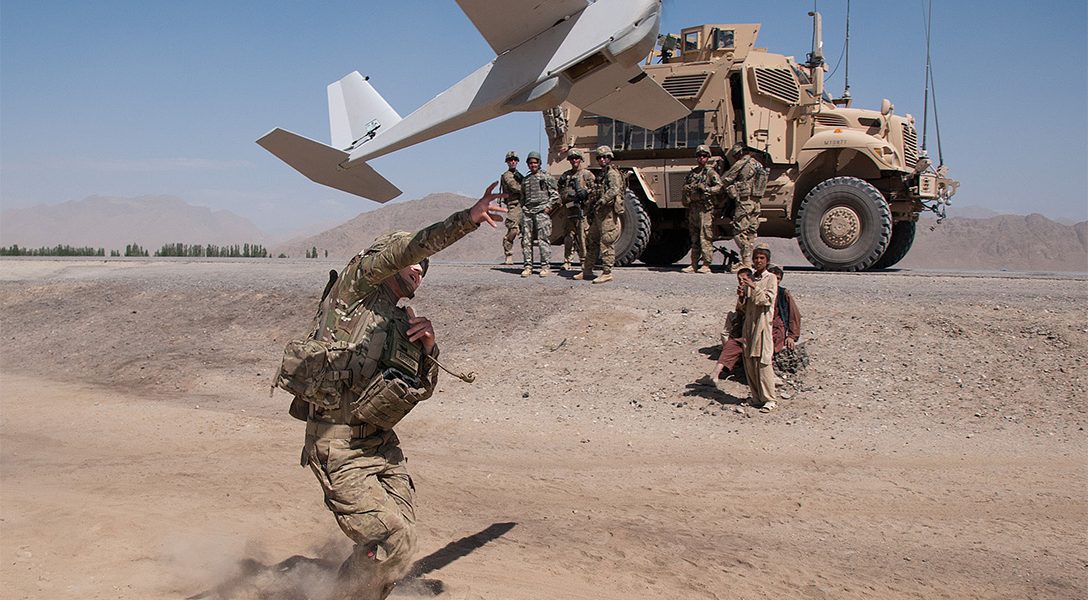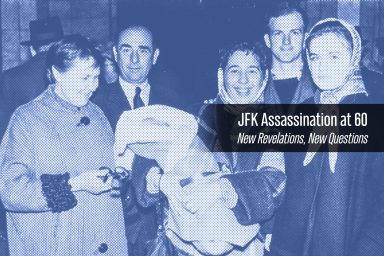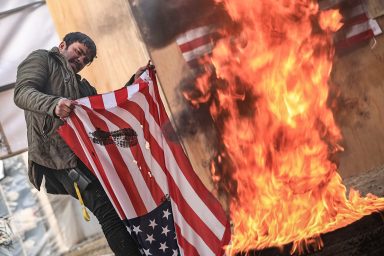The High Price of 16 Years of Failure in Afghanistan
How the US and Afghan government have sowed the seeds of ISIS
A look at how the US has favored and funded terror groups since long before 9/11.
Why is America’s war in Afghanistan the longest in US history? To find the answer, says Matthew Hoh, just follow the money.
This week, on our WhoWhatWhy podcast, Jeff Schechtman talks with Hoh, a Marine Corps veteran and diplomat, who resigned his State Department Afghanistan posting in protest over the war.
What he saw early on convinced him that neither the US nor the Afghan government had any interest in bringing the war to an end. While he witnessed many efforts by the Taliban to at least talk, none of those efforts were ever reciprocated.
Instead, he saw first-hand the proliferation of weapons, military contractors getting richer, and vast sums of money going into the pockets of warlords and drug kingpins. (Go here to see our earlier story on this.)
According to Hoh, now a senior fellow with the Center for International Policy, the war has been a failure on every level. Yet, he tells Schechtman, it continues because there is so much money involved, and those benefiting have power far outweighing that of those suffering.
He also talks about ISIS in Afghanistan, and how it is nothing more than a rebranding of other, older extremist groups, united by the failed policy-driven actions of Afghan and American intelligence services.
Click HERE to Download Mp3
Full Text Transcript:
As a service to our readers, we provide transcripts with our podcasts. We try to ensure that these transcripts do not include errors. However, due to resource constraints, we are not always able to proofread them as closely as we would like, and we hope that you will excuse any errors that slipped through.
| Jeff Schechtman: | Welcome to the program. I’m Jeff Schechtman. The war in Afghanistan, once referred to as “the good war,” is, at 16 years and counting, America’s longest war. In fact, the case can be made that American efforts at disruption in Afghanistan started long before 9/11. In fact, CIA efforts in the country have antecedents as far back as the 1970s. Still, after the loss of 2,000 American lives, countless lives ruined, four billion a year to prop up the country, and tens of thousands of civilians killed, we are still no closer to success; 8,400 troops are still in country and 5,000 more may be on the way, a mere fraction of the 100,000 that were once there. What do we have to show for it? A failing Afghan government, a 10-fold increase in the number of terror groups in Afghanistan since 9/11, and no end in sight. |
| My guest, Matthew Hoh, knows all of this only too well. He’s a Marine Corps veteran and diplomat, who resigned his State Department post in Afghanistan in 2009 in protest over the war. He is currently a senior fellow with the Center for International Policy, and it is my pleasure to welcome Matthew Hoh here to Radio WhoWhatWhy. Matthew, thanks so much for joining us. | |
| Matthew Hoh: | Hi, Jeff. Thank you for having me on. |
| Jeff Schechtman: | First of all, tell us a little bit about your experience, both as a Marine and as a diplomat up until 2009 in Afghanistan. |
| Matthew Hoh: | Sure, well, I had joined the Marine Corps in 1998, a couple years after college, and I served in a variety of capacities as a combat engineer officer, but also had served in the Pentagon. It was from the Pentagon that I got a position on a State Department team in Iraq in ’04 and ’05, and so I got to know people in the State Department. In ’06-’07, I commanded a Marine Corps company in Iraq, but during that time, I was also working over at the State Department. |
| In 2008, as the State Department was looking to expand its presence in Afghanistan, as the United States shifted its focus from Iraq to Afghanistan, and that was a really interesting thing to observe, was that shift in 2008, from the priority of the Defense Department and the CIA and the State Department and everyone else, going from Iraq to Afghanistan in the course of a matter of months. There I was given the opportunity to join a State Department mission in Afghanistan, as a political officer, and so I did that. I went and got there in April of 2009, but it quickly became apparent to me that any thoughts I had about this war, about us having had learned our lessons about the Obama Administration wanting to end the war and get out of the war, that general officers like David Petraeus were going to utilize and really act on the understanding that these wars cannot be won militarily. They can only be settled through negotiations and through reconciliation and through political compromise, like what we saw in Iraq in ’07-’08. | |
| It lasted up until around 2013 or so, where political compromise between the various groups in Iraq brought the violence down. There are other factors, too, but it was primarily the political actions in Iraq that diminished the violence so dramatically, after 2007 and 2008. I thought that’s what we’d be doing in Afghanistan, but not long after I was there, I realized that, no, that the purpose here is to escalate the war, to win the war for political purposes back home in the United States. I just couldn’t go along with that. I mean, I had gone along with it in Iraq, had really done damage to myself, because of that, and, as I realized during the course of the five months that I was there, before I left, that what was occurring in Afghanistan was no different than what had been occurring in Iraq, and I couldn’t go along with that. | |
| I got along for long enough, and so, yeah, I resigned. My resignation went through in September of 2009. Yeah, I came home, and I’ve been working on issues of peace or anti-war since then. | |
| Jeff Schechtman: | One of the things that you saw during that period, around 2008-2009, that I gather made it more frustrating for you, is that there were opportunities for negotiation. There were opportunities for discussion and dialogue, none of which were taken up. |
| Matthew Hoh: | That’s absolutely true, and you can see this in … There’s been more reporting on it over the last couple of years. Last December, so about 10 months ago, the New York Times reported that the Norwegians had finally started talking about this, that in the years 2007, 2008, into 2009, they were meeting with the Taliban to bring about a peace agreement, a peace settlement, in Afghanistan, and the Norwegians actually met with Mullah Omar, who was the leader of the Taliban. It was a long myth, up until just last year, that Mullah Omar had never even met with anybody from the West, for whatever reason, and here we find out, as the New York Times reported, that the Norwegians were meeting with him. |
| What the Norwegians, of course, said was that, “We had to keep this secret from the U.S., because the U.S. had no interest in peace.” You saw this, as well, from the man named Sherard Cowper-Coles, who was the United Kingdom’s top diplomat in Afghanistan, and then became NATO’s top diplomat in Afghanistan. When he resigned over the war and basically resigned in protest from the UK Foreign Ministry in 2010, I believe, end of 2010, his comments, too, were, “The United States is not interested in peace in Afghanistan. They’re the biggest obstacle to peace.” | |
| We saw this over and over again. Anand Gopal is probably the best source. He’s a journalist. His book is called No Good Men Among the Living, and it’s probably the best book about Afghanistan that I can recommend, but he’s been in Afghanistan for years, worked in Afghanistan for a long time, Anand, and he has done some of the best work, as a western journalist, in terms of showing how, after 2001, the Taliban did try to surrender. They tried to surrender many times, and that was constantly rebuffed. | |
| This is consistent with what I saw there, in terms of as my position in Afghanistan, being both in the East and in the South of Afghanistan, having contact with people, who were interlockers for the Taliban, who would speak to us and say, “Look, we want to talk. We want to have … We don’t want this war to go on forever. We don’t want our children and our grandchildren to suffer as we’ve been suffering, but we’re not going to surrender.” They were willing to talk. I mean, this could again be further verified by looking at the media from Central Asia, from Southwest Asia, from the Middle East, through the periods of ’07, ’08, ’09, into ’10, where there are near constant references to the Taliban or statements from the Taliban to the fact that they are interested in talking. | |
| You contrast this with what you heard from our leadership, what you heard from President Obama, or President Bush, or Secretary Clinton, or Secretary Rice, or any of the generals or defense secretaries, that the Taliban are not interested in talking, and that was not the reality. That’s been a lie that has enabled the war to continue, and the main reason being was because both administrations have wanted victory in Afghanistan for, what I believe are purely domestic purposes. | |
| Jeff Schechtman: | How much of the history of American involvement in Afghanistan did you know when you went there, and how much have you subsequently learned, particularly about some of the CIA efforts that went on back in the late ’70s and throughout the ’80s? |
| Matthew Hoh: | I wasn’t as well-read or understood as I should’ve been. I say that, meaning I have read the list of required books, or recommended books, for State Department and military officers. I’ve read a lot of the popular books that have been written about Afghanistan, from some of the more popular authors, like Ahmed Rashid, but those were always written through a lens of a westerner’s eyes. So often, what I was reading took September 11, 2001, as the start date of the war. That’s where the big book picked up. Maybe there were some things in a preceding chapter or an intro chapter about some history, but what I had read that was influential to me, was reading about the Soviet Union’s experiences in Afghanistan. |
| That’s where I primarily understood the genesis of the conflict, understanding how the conflict came about in Afghanistan, what Afghanistan was like prior to the civil war that erupted prior to the Soviet Union’s entrance into Afghanistan or invasion of Afghanistan in December of 1979. While I was there in Afghanistan, I worked very closely with the governor of the province. I used to eat lunch or have dinner with him every day. We lived across the street from each other, basically. My job was to be his advisor. | |
| The governor had read most of these books that were recommended reading for Americans in Afghanistan. He was very critical of them. He had spent a lot of time in the West, as well. His view was basically, if I gave you a 300-page book to read about the United States that only encompassed the last several years, why would you think that would provide you with a sufficient knowledge to operate here politically and understand the conflict that’s going on? That really struck me. | |
| I didn’t read as much local Afghan or Central Asian sources as I should have, and it was a very good learning experience, but there was also a book, too, that I found while I was there, and I think his last name is Griffith. The book was called Reaping the Whirlwind, and it was written in 1996 or 1997, shortly after the Taliban came to power, about the rise of the Taliban, by a man who was in Afghanistan — I believe he was British, if I recall correctly — who was there as an aide person. He was working for an NGO, doing humanitarian work. That book really helped me to understand the conflict in its current form, through the eyes of someone who was there prior to 2001. | |
| I read that book almost nearly as soon as I got there. I just happened to stumble upon it on one of our bases, just lying around. That book really helped, and so I started looking at the conflict, erasing 9/11 from my mind, with the conflict and looking at the conflict as a whole, looking at history as having no start date, no arbitrary beginning. That really helped me understand that the conflict in Afghanistan was this civil war that goes back to the ’70s, and, just as importantly, understanding what Afghanistan was like prior to the start of that civil war, when there was a period of about four decades of peace in Afghanistan. Having that understanding really did help me better understand what’s happened in Afghanistan and how impossible the American idea of winning in Afghanistan was, using the term “winning” as American generals or politicians would use it, in terms of the military defeating the Taliban, getting the entire country to form under one government that is propped up and sustained by an outside power, realized it’s just not possible. | |
| Jeff Schechtman: | One of the points you’ve made is that there’s certainly winning going on economically, that there’s a lot of people making a lot of money in all this. |
| Matthew Hoh: | Yes. |
| Jeff Schechtman: | Talk about that. |
| Matthew Hoh: | Yeah, yeah, absolutely. I actually have been all morning reading about drug production, illicit drug production around the world, and certainly the Afghan drug trade is well known, well understood. It’s massive. The Taliban have reduced it to barely zero. Again, we have to understand and realize that there was no opium or poppy cultivation in Afghanistan prior to the Afghan Civil War. Prior to the ’70s, there was not much cultivation there of illicit drugs. It’s the start … It’s the civil war. It’s the CIA, combined with the Pakistani Intelligence Services, who first start producing these … encouraging the production of these poppy fields, which become opium and heroin and other drugs, in Pakistan, and then that shifts into Afghanistan, at some point, in the ’80s and early ’90s, and Afghanistan becomes the largest poppy or opium producer in the world. |
| The Taliban stopped that for a bit of time, but then, as soon as 2001 happens, and the Taliban are out of power, production goes right back to where it was, and now every year there are record crops of poppies, which produce, again, the opium and the heroin and everything, in Afghanistan, the exception being last year or in 2015, when there was a decline due to reasons regarding weather and I think some blight and some other naturally occurring reasons. No, so you have … The United States has spent about eight billion dollars total, since 2001, trying to stop the drug production in Afghanistan, but every year, again, there are record crops. Now Afghanistan has, depending upon who you speak to and who you look at, anywhere between 70% and 90% of the world’s opium production. | |
| You look at that, and the amount of money being made off of that, and, at the same time, too, we lie about that. We say that that poppy production, that opium production, is what the Taliban do, but that’s a lie. Now, I’m not going to say the Taliban is not involved in the production of it. They certainly are. They certainly tax the drug trade, where they can. But, the people who control the drug trade in Afghanistan, the people who have profited the most from the drug trade in Afghanistan, and this is about a two to three billion dollar a year industry in a country that has no industry … Remember that, according to the United States Senate and according to the Special Inspector for Afghan Reconstruction, about 90% of Afghanistan’s GDP comes from outside support, from other countries, particularly the United States, so that two or three billion a year makes this the biggest, most profitable industry, the only industry, again, really, in Afghanistan. | |
| The people who benefit from this are the people who are in the Afghan government. They are the warlords. They are the militia commanders. They are the generals, and they are the politicians, who run the Afghan government, and who we have been working with, and we have put in power and kept in power since 2001. | |
| On the other side of the planet, back here in the United States, the defense corporations have made so much money off of this. You are looking at about 800 billion dollars spent on the Afghan war since 2001, and that’s only direct costs. That doesn’t break out the costs that … That doesn’t exclude the fact that the Pentagon’s base budget — so the non-war specific costs, so the training of soldiers, the buying of ships and planes and tanks and that kind of stuff — has basically doubled since 2001. These wars have been a windfall for the defense and intelligence companies, making record profits. | |
| Their CEOs make 15 or 20 or 25 million dollars a year, and this, in turn, allows for an area, say, like Washington DC to have, and again, depending upon which server you look at, which magazine, whether it’s Fortune or Money Magazine or whatever you look at, but the Washington DC area to have five, six, or seven of the wealthiest 10 counties in the United States, in terms of salaries, in terms of household wealth, because people are making so much money off of this. Not just the CEOs, but the people who work for the defense corporations, are making six-figure salaries, simply because they possess security clearances. | |
| The war, like I think all wars, has been a bonanza for a variety of interests: the drug interests as well as the defense and intelligence company interests. Other than that, it’s hard to find or pick out someone else who has benefited, with the exception of some of these extremist/Jihadist terror groups that have been able to utilize the American presence in Afghanistan, as well as other places around the world to justify their actions and recruit more followers, recruit more foot soldiers, recruit more people to support them. This is particularly important when it comes to where does the Taliban … The Taliban’s not getting their money from the drug trade. Well, they get it from, primarily, they got a lot from the Pakistanis and a lot of that money actually came from us. However, they get most of their money, and this is what we knew in 2009, most of their money, or plurality of their money, comes from wealthy donors in the Middle East, particularly Saudi Arabia or Kuwait, who support this cause of theirs, fighting the Americans in Afghanistan. | |
| Jeff Schechtman: | One of the things that we’ve seen is the tremendous increase in the number of terror groups in Afghanistan, from just the Taliban that was there in the beginning to dozens and dozens of groups now. |
| Matthew Hoh: | Oh yeah, yeah. I mean, Jeff, if you want the simplest metric to understand how the American war in Afghanistan has failed, if you’re going to say the purpose was to fight terror groups and to stop the spread of transnational terror or extremist groups, well, yeah, in 2001, the United States had only Al-Qaeda listed as a terror group in Afghanistan. If you want to combine the Taliban with that, you can do that, as well. Now, as General Nicholson, who is the Commander of American Forces in Afghanistan, testified earlier this year to the U.S. Congress, there are now 20 terror groups or extremist groups, or however you want to describe them, operating in Afghanistan. |
| I mean, and we’ve seen this in the sense of, as well, too, in 2001. We know, because the FBI seized documents in Kabul. We know from journalists, say, like Peter Bergen. We know from people who’ve left the FBI, who were very much involved in counter-terrorism, like Ali Soufan, that … During 9/11, in September of 2001, the strength of Al-Qaeda was between 200 and 400 people. That was it. Now, there is this organization that spans throughout the world, as well as similar organizations or other types of organizations, plus the Islamic State, which didn’t exist until the American actions in the Middle East. | |
| We really have to understand that, that look, Al-Qaeda had been active. It wasn’t like Al-Qaeda had just been created in 2001. Throughout the ’90s, they had declared war against the United States. They had declared war against Middle Eastern governments. They had a whole litany of attacks on targets, American targets or Saudi Arabian targets, throughout the Middle East. Again, at this point, in 2001, they’ve only got a few hundred people total, and one of the reasons I think you can say is … Those 19 people they used for the hijackings, well, they used 5% or 10% of their force for that, but now again … Yeah, we look at it now, 16 years later, and you see what has happened in Syria, what has happened in Libya, their ability to recruit online, motivate people, and what we find… | |
| There was just another report backing this up and verifying it, that this understanding of why people join these groups is really becoming just rote. It’s so well documented, even though our politicians, in general, say another thing. The United Nations just did a study in Africa, and they find that the people who join the militant groups in Africa — like they’ve got Al-Shabaab in Somalia, Boko Haram in Nigeria, or Al-Qaeda in North Africa, in Libya, in that area — more than 75% of them join these groups, because they’ve had somebody in their family, in their village, a relative, somebody killed by the government. They join these groups as a way of fighting back, and we’ve seen this over and over and over again. Yeah, we had … If you’re going to state that the purpose of the United States in Afghanistan and in the Middle East has been to fight terror, well, you have to really accept the fact that it’s been a colossal failure. | |
| Jeff Schechtman: | It’s been a failure on every level, even in terms of the Afghan police and the Afghan army, and that’s been a failure, as well. |
| Matthew Hoh: | Yeah, and it’s such a failure that the Special Inspector General for Afghan Reconstruction … The guy’s name is John Sopko, who’s just done incredible work. I think years from now, we’ll look back and we’ll say who had integrity in this period, and Sopko is one of them. Really, him and his people are doing great work, going against the grain. His report … The Special Inspector General’s Office puts out reports once every quarter, and the main headline out of this latest report is that the United States, the Pentagon, is no longer going to release the numbers of Afghan soldiers, of Afghan police, not going to release how many Afghan soldiers or police have been killed or have been wounded or have deserted. They’re going to classify all that information. |
| Now, as John Sopko says, we’ve spent 120 billion dollars on development in Afghanistan since 2001. Sixty percent of that has gone to the military or the police, so you’re talking about — what? — 70 some odd billion dollars of American taxpayer money, and now the Pentagon is going to say, “We can’t tell you this information any longer,” and the reason being, of course, Jeff, is because the war is going so badly, has been going so badly, that they just don’t want this information out there any longer, in terms of the number of Afghan soldiers and police being killed. | |
| Every six months, when that number would be reported, it’d be a record on the previous number. The number of casualties, as well as, too, the number that are deserting … We see desertion rates. Up to one third of the force deserts. We see about … The last figures I saw were from August, but 33 Afghan soldiers and police were being killed every day in Afghanistan. | |
| At best, if you want to call it a stalemate, you can, but they really are losing, particularly when you look at the investment that the United States has put into them, in terms of the amount of American lives that have been lost, the amount of Americans that have been wounded, and the amount of money we’ve spent doing this, with the purposes again, or the strategy, I should say, since 2009 in particular, being we’re going to train them, the Afghans, and they’re going to be able to fight on their own and defeat the Taliban. Now, it’s going so poorly that the American government won’t even tell you how many Afghan soldiers there are. | |
| This reminds me very much of what happened in 2013, when the war was going so badly in Afghanistan. Every quarter, the Defense Department has to submit a report to Congress. In that report, they used to include the number of attacks launched by the Taliban, the number of roadside bombs that they had put in the ground, the number of attacks on bases, and, in 2013, after the Pentagon was caught lying about it, by either the Associated Press or Reuters, the Pentagon stopped publishing that information, because every time they published it, it was getting worse. Every time they published the information, there had been more attacks than last time. The Taliban was stronger than last time. They were more effective than the last numbers. This, of course, ran against the narrative that we were winning in Afghanistan, that our actions were being successful, that we were on the right path. | |
| Similarly, there was another period of time prior to that, a couple years before that, where they used to publish, the Pentagon used to publish, in the same report, used to publish information on political control. They would do assessments, and who controls what part of the territory. In this province, how much control does the government have? They would get into specifics about it. Does the population lean in support of the government or lean in support of the Taliban. By some point in 2010, they stopped publishing that information, after publishing it for only a year or two, because the information was so negative, because the information showed that the Taliban controlled so much territory, and the government was so unsupported in large parts of the country, that it was a public relations disaster to have that information being publicly released. | |
| Jeff Schechtman: | Where does ISIS fit into the equation in Afghanistan right now? |
| Matthew Hoh: | Well, you know ISIS is a pretty interesting story in Afghanistan. This comes to us from the folks at the Afghanistan Analyst Network, and they are Afghan based. They are about one of the best sources of reporting and journalism research available, and they are very objective. It’s 2017, so about four or five years ago, the Afghan Intelligence Service, the NDS, along with the American Intelligence Service, too, started paying Pakistani Taliban and Afghan Taliban members to fight against the Taliban, the idea being that you would cause such disarray, you would cause a split in the ranks, you’d cause all kinds of friction, and it would hurt the Taliban. |
| Well, that didn’t really work. When the NDS and the CIA stopped paying these guys, dropped their support of them, well, you had these men, who were still committed to fighting, who were still committed to whatever cause they were following, being Pakistani and Afghan former Taliban members. They were in Afghanistan at this point, and what they did was they just rebranded themselves. They re-marketed themselves. They started calling themselves the Islamic State in Khorasan, Khorasan being a reference to an end-of-times prophecy in Islam about a Muslim army coming from the region that was then known as Khorasan, which includes Afghanistan, in an end-of-times battle, basically. | |
| They rebrand themselves, like really smart marketing, because, at that point, 2014-2015, into 2016, the Islamic State is on the rise, and if you call yourself some name in Pashto or in Urdu or in Arabic or Engari, or whatever, that people in the West don’t understand, you don’t get much attention, but if you call yourself the Islamic State, then you get on the front page of the Washington Post, then you get on the front page of the New York Times. You start to attract real attention, as well as, too, they’re hoping to tap into the financial support that comes with the name Islamic State, again, from those wealthy donors in the Middle East, particularly Saudi Arabia, that provide so much of the financing for these various armed militant Jihadist groups around the world. | |
| Yeah, so they’re not really the Islamic State, per se. It’s not like a bunch of Islamic State fighters from Syria or Iraq got onto a bunch of planes and flew to Afghanistan and are now there. No, these are guys, who’ve always been there, who actually came together as an organization because of a failed plot by the Afghan and American Intelligence Services and then simply just rebranded themselves as the Islamic State and got the attention they were seeking. Of course, now, because of that, they’ve been attacked quite a bit by the American and Air Forces, but there was a period of time several years ago, and this is documented … Here, you can see this in the New York Times from a number of years ago, actually, where these men were not being touched by the Afghan Army, and so, again, they were trying to split the ranks of the Taliban, but, no, that’s how the Islamic State has come to be in Afghanistan. | |
| Jeff Schechtman: | Finally, Matthew, what is your sense of why the war even continues at this point? |
| Matthew Hoh: | No one’s willing to admit defeat. The war continues for a variety of really tragic, awful reasons, but I think people who can see these reasons in history … It continues, because a lot of people are making money off of it. It’s been so profitable. Again, we were talking about the drugs. We were talking about the defense industries. |
| I mean, give you an example, using the numbers from the Congressional Research Service, for each of the … so President Trump, back in the late summer, when he announced his policy in Afghanistan, and the numbers are going to be about 4,000 troops are supposedly going to go there. A lot of people said, “Well, 4,000 troops is not a lot,” but, again, using the Congressional Research Service reports, for each of those troops, you can expect two and a half contractors now to also be utilized, excuse me, and that turns out … | |
| Then, also, too, if you look at, in terms of how much money the war costs, and we’re spending about 45 billion dollars a year in Afghanistan, just on direct costs, so the costs for the bomb drops, the cost for the fuel for the planes, the cost of the food to feed our soldiers there, that kind of thing … By using that rule of thumb of how much it costs to support the war, you see, we’re looking at anywhere, for 4,000 more soldiers going, being 10 to 15 billion dollars more a year in Afghan war costs. I mean, it’s simply astounding. | |
| I mean, you have other issues, too. You have a civil war that’s been going on for decades now. It’s been going on since the late ’70s. At this point there’s no attempts at reconciliation, which is what you need, to bring about any peace. You have a government in Kabul that is illegitimate. I mean, the three national elections in Afghanistan that have been held since 2009 have been incredibly fraudulent, just glaringly fraudulent. It’s amazing. | |
| As long as you have a government in Kabul, a government that is profiting, that is made up of the people who are profiting, rather than of the people who are suffering from the war, this war is never going to end. The Taliban, of course, are fighting, because the bulk of them … Masses of them are fighting, because they are occupied or because of grievances or because they had a relative killed by the Afghan government or the American military. I mean, there’s lots of reasons. Not very many of them actually fight out of religious Jihad or any of that kind of thing. Until you have a government that is composed of the people who are actually suffering and hurting from this war and a policy that is aiming to achieve reconciliation, as opposed to victory, and as long as people are making lots and lots and lots of money off of this, you know, Jeff, I just don’t see it ending anytime soon. | |
| Jeff Schechtman: | Matthew Hoh, I thank you so much for spending time with us here on Radio WhoWhatWhy. |
| Matthew Hoh: | Oh, thank you, Jeff. I really appreciate it. |
| Jeff Schechtman: | Thank you. Thank you for listening and joining us on Radio WhoWhatWhy. I hope you join us next week for another Radio WhoWhatWhy Podcast. I’m Jeff Schechtman. If you liked this podcast, please feel free to share and help others find it, by rating and reviewing it on iTunes. You can also support this podcast and all the work we do by going to whowhatwhy.org/donate. |
Related front page panorama photo credit: Tari Sar observation post before mortar attack on Shigal Tarna garrison, Kunar, 1987; Adapted by WhoWhatWhy from observation post (Erwin Franzen / Flickr – CC 2.0).





